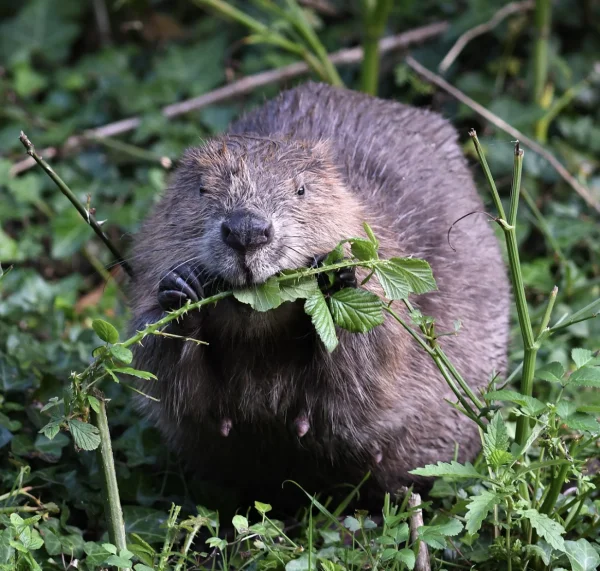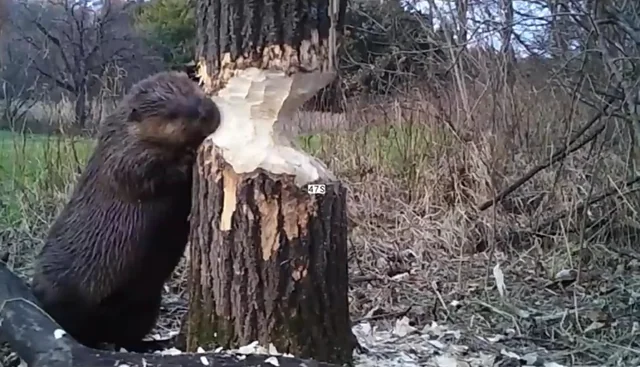What do beavers eat? Beavers are true vegetarians, living exclusively on woody and aquatic vegetation. Their diet consists primarily of bark, twigs, and buds from deciduous trees like poplar, willow, birch, and maple, and leaves, stems, and roots from aquatic plants like cattails and water lilies.
Animals employ their dexterous front paws to construct dome-shaped lodges in ponds that can then be plastered with mud which hardens in winter and acts as an insulated den for their family. Let’s know in detail what do beavers eat as well as other facts about beavers.
Who are Beavers?
Beavers are one of the few mammals able to alter their environment, often being known as ecosystem engineers. Beavers build dams out of branches, twigs and leaves covered with caulking material such as mud to form ponds that provide habitat for diverse aquatic species.
They have even been observed digging canals from larger bodies of water into their own ponds, all the while contributing their share to habitat creation!
What do beavers do?
Beavers spend most of the year dining on cattails, pond lilies, and grasses from their ponds, while also stockpiling branches on the floor to use during winter when food becomes scarcer.
Beavers are highly intelligent creatures with the ability to communicate among family members by slapping their tails against the surface of the water and communicating this way.
They are nocturnal animals that become active between dusk and dawn. Beavers live in monogamous pairs which share duties such as food preparation, building lodges, and raising young. Young siblings may live with their parents for up to two years after leaving home.
Body of Beavers
Beavers possess thick coats ranging in color from yellow-brown to almost black in hue, webbed feet with digitated front paws, and large orange front teeth that self-sharpen. These teeth can cleave through willow branches the size of your finger in one bite! However, if these teeth grow too long they could prevent beavers’ mouths from closing to meet grinding molars properly which would result in starvation and starvation of their prey.
What do Beavers Eat?

So what do beavers eat actually? Beavers are herbivorous animals that consume aquatic vegetation such as cattails, sedges, and water lilies as a primary food source. In addition, they eat bark from woody plants such as birch trees and shrubs as well as bark from other trees such as aspen, and alder maple willow trees when available; when food sources become available they raid farms. They store branches underwater as winter food caches.
Beavers utilize their feet in both terrestrial and aquatic environments, featuring small dexterous front feet with five digits that are designed to grasp sticks. Meanwhile, their hind feet feature webbed for swimming with no fur covering them except on their dorsal surface where there is a preening toe that allows them to maintain waterproof and insulating fur coats on them.
How do beavers eat?
If you’re finding out what do beavers eat, you must also know how they eat. Beavers’ incisors are sharp and grow at an unpredictable pace, necessitating them to constantly chew to wear them down and prevent infection. According to research, beaver gnawing action releases scent for marking territory, communicating among family members, and warning of imminent danger (beavers can deliver powerful bites!). In turn, beavers use scent release as a marking action or release warning scent when threatened – it also releases odor for marking territory and communicating.
Beavers are monogamous creatures who live in family colonies. Beavers tend to be crepuscular, meaning that they tend to be most active between dawn and dusk when temperatures are lower and predators less dangerous. Their castor glands produce scents for marking territory as well as oil to waterproof their fur, helping protect it against harsher climates by storing fat reserves in their tails.
How long do Beavers Live?
Beavers live in family groups and typically remain with the same mates for life, making their dam-building skills passed down from parent to offspring through generations. As what do beavers eat has been explained already, lets know what do they eat? Beavers eat roots, buds, leaves, and twigs from deciduous trees as well as aquatic plants like pondweed and water lilies for food sources. They store food for winter in mud-coated branches that they place into the bottom mud of the pond for storage; they even farm water lilies by separating and replanting bulb sources from bulbs!
How do beavers chew so hard stuff?

Beavers possess long, dark orange incisors that constantly grow throughout their lives and are self-sharpening. To wear down their soft tissue (cambium) beneath, beavers chew on bark and woody material such as bark from trees; tree buds; buds from willows and aspens trees, in particular, are favorites of theirs for harvesting their inner bark; in addition, they feed upon aquatic plants such as reeds and cattails to obtain nourishment from within their soft inner bark – their soft inner bark being consumed from aquatic plant sources such as aquatic plants from which their soft inner bark has also grown throughout life – an essential process!
Beavers in Water
Beavers are slow swimmers that can remain submerged for up to 15 minutes at a time. Their back feet feature fully webbed hind feet used for propulsion while front feet boast small with long claws designed for digging food holes and handling food items. Beavers may be vulnerable to predators on land but remain safe underwater because their ears and nose close when submerged and eyes have transparent valves covering their pupils; in addition, beavers also possess waterproof scent glands.
Characteristics of Beavers
- Beavers are powerful agents in nature, altering their environment in ways few other animals can.
- Beavers influence water flows, provide habitat for other wildlife species and help mitigate floods – hence their influence has earned them the nickname “busy as a beaver.”
- Their large teeth never stop growing so they chew tree branches and bark for nourishment while simultaneously wearing down their sharp cutting teeth which can cut wood.
- Beavers also exhibit engineering prowess by building dams to form ponds and channels.
- Beavers possess webbed hind feet adapted for swimming, with small front paws which are adept at grasping sticks and other objects.
They can hold their breath underwater for 15 minutes at a time while controlling blood chemistry, heart rate, and circulation through skin on their chin and tail (a special gland secreted by their cloaca at its base). Their transparent eyes enable them to see when swimming underwater while flaps close shut to keep water out of their noses and ears.
The Final Say!
Beavers are monogamous creatures that mate from January through March, producing litters of one to eight kits (usually four) which remain with their mother for up to two years after hatching. Beavers can carry diseases like Tularemia and Giardiasis that can be spread through contact with infected feces, drinking contaminated water sources, or flea bites – these infections typically spread via direct contact or flea bites.
Well, you came here to know what do beavers eat and left with knowing all the amazing facts about beavers. For more interesting facts & knowledge, keep visiting. Bye!







